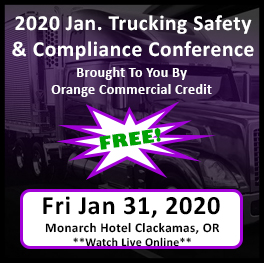
5 Ways to Prepare for ELDs in a Full Compliance World
posted in Alerts by Brian Gray
5 Ways to Prepare for ELDs in a Full Compliance World
Sponsored Content By EROAD
The ELD mandate has entered its final phase of compliance and the grandfathered era for AOBRDs is over. All drivers and carriers subject to the rule must use FMCSA registered ELDs. If your driver is not equipped with a compliant ELD, he/she will be considered to have no record of duty status and be put out-of-service.
As we enter full compliance, are your fleets and drivers prepared? Take a look at five ways you can prepare for the new world of compliance.
- No more wiggle room – Planning is key to this new era. With more fleet visibility, be aware of a few mishaps that both new and experienced ELD users run into.
- Make sure your drivers are taking their full 30-minute breaks. ELD technology is precise, which means if your driver takes a 29-minute break, he could be in violation. Take a 31-minute break just to be safe.
- With crowded rest stops and limited parking across the country, make sure you allot extra time in the driver’s route for finding a place to safely park or pull over for breaks.
- Proactively manage HOS violations. Many ELD suppliers will provide reports within the system that allow you view HOS violations within a specific period. By watching trends overtime you can coach and train drivers to avoid violations overall.
- Roadside Inspections – With paper gone, and AOBRDs a thing of the past, digital inspections requiring data transfer from ELD to inspector are the new norm. It’s pertinent that your driver knows which transfer option their ELD is equipped for and how to transfer the files when asked (Telematics – web services and email or Local – USB and Bluetooth). If the transfer is not available for any reason, the ELD must have a backup option to present the driver’s log information to enforcement by either display or printout. Compliant ELDs are designed so that a safety official can read the display without entering the truck.
- Audits – It’s a smart idea to perform internal audits on a regular basis so you are prepared for the real thing. You may be asked for a wide variety of data, including DVIRs, maintenance records and record of duty status (RODS) for your drivers electronically. For the driver’s RODS information, the auditor will expect to view your records on the FMCSA’s online eRODS application. The RODS data should be exportable from your ELD provider’s back-office system. The FMCSA requires you to keep the most recent six months of driver logbook data. When exporting any data for the auditor, only export the very tight range of data that they request. Otherwise the auditor will have to work through all the information to get to the data they need to evaluate, and you may be exposing yourself by giving them more than they need. Data exports should contain relevant notes that explain any device malfunctions and unidentified trips but should not include any violation warnings. The auditor will use the eRODS application to determine any potential violations based on the raw driver RODS data transferred.
- Training – Make sure your teams know how to use their new technology. Your mechanics, back-office staff and drivers need to adjust to the new system and processes, and training can make a big difference. Understanding how to accept, annotate and edit trips will be important to a driver’s success at roadside. There will be mistakes, but a driver that truly understands how to use his ELD will be in great shape. Any edits by driver or carrier must have an annotation explaining the reason. Carriers may suggest edits on submitted driver’s logs, but the driver must accept or reject the proposed edits and recertify. Make ELD training dynamic by planning classes, doing ride-alongs and webinars to offer drivers a thorough overview of safe ELD use, including transferring eRODS during inspection, and editing and annotating their logs as necessary. You’ll also want to work out how drivers should be using the devices for Yard Moves and Unidentified Trips and creating policies for those special driving statuses.
- Better your fleet with data – Technology has given us greater insight to business operations. Use and share your data to help your drivers be successful. Driver behavior data, such as harsh braking and speeding can be helpful for coaching and improving safety overall. Fleet technology equipped with proactive monitoring tools like the EROAD Overspeed Dashboard can show you the number of speeding events by vehicle or driver over a period of time. For each driver, you can view the areas where they frequently speed and coach them individually. Creating a safer fleet is at your fingertips. Use your data insights to boost CSA scores, increase driver morale and build a better fleet.
Hear more from Soona Lee, EROAD’s Director of Regulatory Compliance, and deepen your knowledge about preparing for ELDs in a full compliance world at Glostone’s 2020 Trucking Safety & Compliance Conference on January 31st.
About EROAD
EROAD provides a complete suite of user-friendly fleet management, compliance and driver safety solutions, including an FMCSA registered and third-party verified ELD, compliant DVIR, electronic tax reporting, vehicle maintenance and fuel and fleet utilization reporting. It’s simple, affordable and smart. For more information, please visit www.eroad.com.







